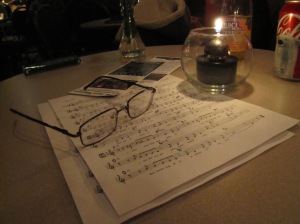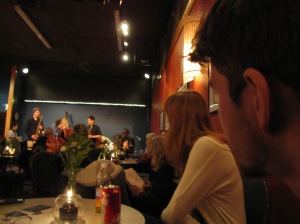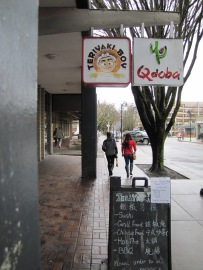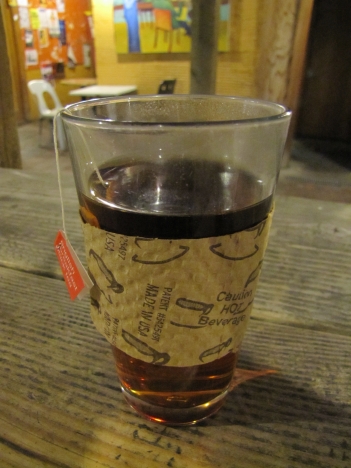Cost: A $3 to $5 donation is appreciated.
Location: 124 West Broadway, just north of Eugene Station.
Distance from Campus: 1.3 miles.
I came to the Jazz Station on a whim.
Passing by a week before, I noticed the Jazz Stations “All-Comers Jam” advertisement. When I read admission was free, I knew I’d have to go in later after the session commenced. When I finally shuffled through the door, the first question the volunteer at the door asked was “Do you play an instrument?” When I responded, “Yeah, a little piano,” she told me to go up on stage and play. I did after other musicians. Not having played jazz with a band for over a year, I found my skills were in need of sharpening. Nonetheless, playing with a combo was a pleasant exercise in improvisation.
This time I came to observe and ask questions. After buying a Coke, I took a seat at a small table near the back of the gallery.

Each table is candle-lit. The charts are “All the Things You Are” and “Corcovado”.
The walls left and right are painted brick red, while the stage wall is a mellow blue. Sketches of jazz artists hang on the walls. Onstage stands a proud jet-black upright piano which reflects and warps the light from the overheads, beckoning any brave soul to come and test her voice. Kenny Reid, on drums, cut out a beat while the bassist, Jack, plucks out a thick line on his upright acoustic. Black, round drink tables topped with mats colored that same rust-red, small spherical candles, and the occasional beer or wine dot the gallery floor. The black and blue accompanying chairs match the stage wall. Whoever decorated the space must have wanted a late-night feel available at four in the afternoon.
Between sets, the room came alive with bustling chatter. To my surprise, I heard old friends reunite (“I haven’t seen you since San Francisco!). Patrons and players alike flocked to the small bar to refill before the next song. Others leaned in close at tables, holding private conversation. An old jazz recording, probably something from the golden age when you could find spots like this scattered around a city like leaves on a late autumn day, played in the background.
The live music started up again. I took a seat next to a Japanese gentleman. After exchanging pleasantries, we chatted. My conversation partner, Tak Kashino, was born in Japan, moving to Eugene about the time I was born in 1994. He said he loves the Station for a number of reasons: Reasonably priced, it provides live music for a three to five dollar donation at the door. He works as a chef, and when he’s off on Sundays, he comes to the Station to hear live jazz. When I asked him to write down his reasons for coming to the Station, he “I don’t want jazz to die in American society”. I asked him about it, and he explained to me that staying in New Orleans a few years back, he was hard-pressed to find a jazz club.

Spotlights keep the combo the center focus. Photo Credit: Alexis Sanchez
Tak and I sit and took in the music together. His friend, another gentleman from Japan, was stroking the keys, making the upright sing. His lighter ‘comping’ style melded well with the singer up on stage, as well as Kenny and Jack. He played with a cool confidence, which seemed to trust his hands to find the right notes while he watched the singer for any kind of visual cues. She seemed flustered, and asks to start the song over (the song was in an unfamiliar key for her), so he patiently played the first few notes and gave her a downbeat. After a few more rough takeoffs, the song gained altitude, and her notes go soaring above the heads of the audience. She sang “Don’t Get Around Much Anymore” with a smoky, bluesy tone, which sent chills down my arms at the time.
The singer, Mary Cutting, who I ran into a nearby tea-house after leaving the Station for the night, listened to jazz as a young girl. She, another performer, Sonya, and I talked for nigh’ on an hour at the tea-house about their experiences with jazz and what brought them to the Jazz Station.
Growing up, Mary “repressed” her musical skills. When she heard about a jam session at the Station in later life, though, she decided to go and check it out by herself. She fell in love with the jam session because any participants in the session didn’t have to be perfect in order to enjoy the experience of making music with others within the improvisational form.

Younger and older folks alike enjoy the intimate ambiance that the Jazz Station offers.
Sonya Christian says one reason for her moving to Eugene was the Jazz Station. The Jazz Station operates as a non-profit, which Sonya said she would like to work with. As a girl, Sonya played classical piano. But she says classical is too confining and strict. She plays jazz piano occasionally on stage, but would love to learn to play the upright bass. When I asked her why she comes to the Station, she harmonized with Mary, explaining that within that gallery, you don’t need to be perfect at your instrument to perform.
Whether you’re a ardent jazz fan that knows the difference between a secondary dominant chord and a tri-tone or an appreciator of all musical styles or somewhere in between, the Jazz Station All-Comer’s Jam offers a enjoyable experience for you. The folks that frequent it show that you don’t have to be a virtuoso in order to take pleasure in the jazz experience. Tak doesn’t play and instrument, but he attends to support his friend and hear live music. Sonya attends because she believes in the Station as non-profit. Mary comes by because she wants to sing in a low-pressure space. From my experience at the Jazz Station, I recommend attending the All-Comer’s Jam.




